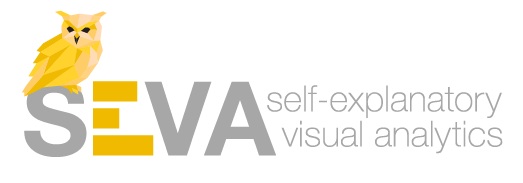
Intro
In the project SEVA we aim to support users in learning novel visual data analysis tools more quickly. Our main goal is to design and develop onboarding methods for visual analytics systems that can be generated automatically. With data journalism and biomedical R&D, we are targeting two diverse application domains. With appropriate onboarding methods the user experience as well as the understanding of visual data analysis tools for large and complex data sets will be enhanced. Methodologically, we will design, build, and evaluate proof-of-concept prototypes along an iterative user- and problem-oriented research process.
Background
The ever increasing amounts of available data offer immense opportunities for progress in terms of technological, economic, and societal development in areas such as industry, biomedicine, or journalism. However, the possibilities to collect and store data increase at a faster rate than the ability to analyse the data and use it for decision making. Visual Analytics (VA) is an emerging area of research and practice that addresses this challenge by combining the outstanding visual perception and reasoning capabilities of humans with the strengths of automated data analytics of computers.
Necessity of Onboarding
Even though visual representations are usually easier to understand than other forms of data representation, users still need to develop skills how to read and comprehend them. Users can be experts in their respective domains but have difficulties interpreting and working with novel visual representations or comprehending the characteristics of data analytics methods. This not only bears the risks of drawing wrong conclusions or failing to tap into the power of data analytics but can also lead to frustration and rejection of powerful data tools. Additionally, as VA is an expanding discipline new approaches appear regularly.
Onboarding methods help users to comprehend data visualizations and to take full advantage of the tools at hand. However, this subject received very little attention from the scientific community so far. Available solutions are mostly focusing on the overall user interface rather than visual representations. Moreover, such help systems need to be custom built and are laborious to create. Thus, they add an economic burden, particularly for small and medium enterprises. The goal of this project are self-explanatory VA tools that actively support users in interpreting visualizations and analytic methods.
The company partners in the project provide VA tools for biomedical specialists and data journalists. Getting users of visual data tools up to speed as quickly as possible is a key challenge that companies face on the market. Being able to apply this technology in their products would be a substantial market advantage with the main benefits of increased user satisfaction and output quality at moderate cost.
Aim
The aim of this project is to create appropriate onboarding methods for VA tools that can be automatically generated. Our vision are self-explanatory VA tools that actively support users in interpreting visualizations and analytic methods. Results will be a conceptual framework of VA onboarding, proof-of-concept implementations, as well as use cases in biomedicine and journalism.
Method & results
A user-centered and problem-driven design approach is followed. The research is informed by cognitive science theory in a transdisciplinary manner. From a technical perspective, it builds on declarative specifications (visualization & data analytics grammars) and proposes a novel method to automatically generate onboarding idioms. By involving software companies from two very different application areas, the relevance and generalizability of the novel technological approach is ensured. Thus, both highly innovative scientific research as well as strong practical relevance is addressed. Results are a conceptual framework of VA onboarding, proof-of-concept implementations, as well as use cases in biomedicine and journalism.
Presseberichte
Forschende der FH St. Pölten entwickelten Lern- und Bedienungshilfen für Visual-Analytics-Tools
04/22/2024Medium: IT Welt
Author: Robert Aigner
Visuelle Datenanalyse erleichtern
04/22/2024Medium: APA
- Technische Universität Wien
- Fachhochschule JOANNEUM
- Landsiedl Popper OG
- datavisyn
